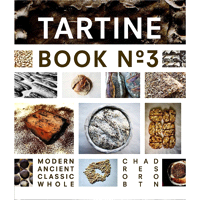
If you have a passion for well-crafted, grainy bread – the kind of bread that has soul, history, and a name, think no further than Tartine. Chad Robertson’s Tartine Book No. 3: Modern/Ancient/Classic/Whole (Chronicle 2013) explores new territory. Introducing bread with Kamut, Emmer, and Spelt, he travels through Denmark, Sweden, Germany & Austria, and France to create bread recipes that balance seeds, grains, and gluten content.
It is, in some sense, a journey backward, an attempt to recapture the flavors of ancient grans, to rejoin our nascent age of invent. Yet many of the ways I use these grains are new – discovered well into the scope of this project and opening up unique and exciting possibilities for baking with flavorful grains. (p. 15)
But even if you don’t make your own bread – yet – buy this book for the stunning photographs of rustic, crusty breads that reveal “a tender, open crumb and substantial caramelized crust (p. 19).” The poppy, pumpkin, sunflower, and caraway seeds in Seeded Wheat (p. 88-91) are sprinkled across the deep brown of the crust. The Sprouted Quinoa-Kamut (p. 116-119 is sprinkled both inside and out with black, brown and white specs under its deep, dark exterior. There are pictures of ingredients, sandwiches, sweets and pastries. There are portraits of the countryside and the bakers he has met. Each loaf is as individual as people are – if only we could taste each one – better learn to bake!
 Chad starts the book with a history and explanation of pre-WWII breads. Most of the recipes call for high extraction flour that is flour that is somewhere between white and whole wheat with more of the bran and germ left in. It requires more liquid to hydrated it – so the dough is wetter and often stickier – if you have ever worked with rye flour, you’ll know that sticky dough is often more difficult, and yet the resulting bread is much more tasty. Mid-way through the book, he starts to explore Rene’s-Style Pan Loaves. These are denser breads with a large amount of sprouted berries and a smaller amount of flour. They are the kind of breads that would go well with rillettes or pate, or shaved into thin slices and toasted according to Chad. There is a whole chapter on crisp breads and crackers – some, like the Kamut Crispbreads (p. 234-9) have edible flowers, herbs and shaved vegetables inside – so that they seem like Japanese paintings of spring fields or rushing brooks.
Chad starts the book with a history and explanation of pre-WWII breads. Most of the recipes call for high extraction flour that is flour that is somewhere between white and whole wheat with more of the bran and germ left in. It requires more liquid to hydrated it – so the dough is wetter and often stickier – if you have ever worked with rye flour, you’ll know that sticky dough is often more difficult, and yet the resulting bread is much more tasty. Mid-way through the book, he starts to explore Rene’s-Style Pan Loaves. These are denser breads with a large amount of sprouted berries and a smaller amount of flour. They are the kind of breads that would go well with rillettes or pate, or shaved into thin slices and toasted according to Chad. There is a whole chapter on crisp breads and crackers – some, like the Kamut Crispbreads (p. 234-9) have edible flowers, herbs and shaved vegetables inside – so that they seem like Japanese paintings of spring fields or rushing brooks.
Tartine Book No. 3 will surprise you with the beauty of bread. Perhaps you will be tempted to create your own, perhaps not. In that case, you might find a ticket to San Francisco to taste some of Chad Robertson’s bread in the near future.
